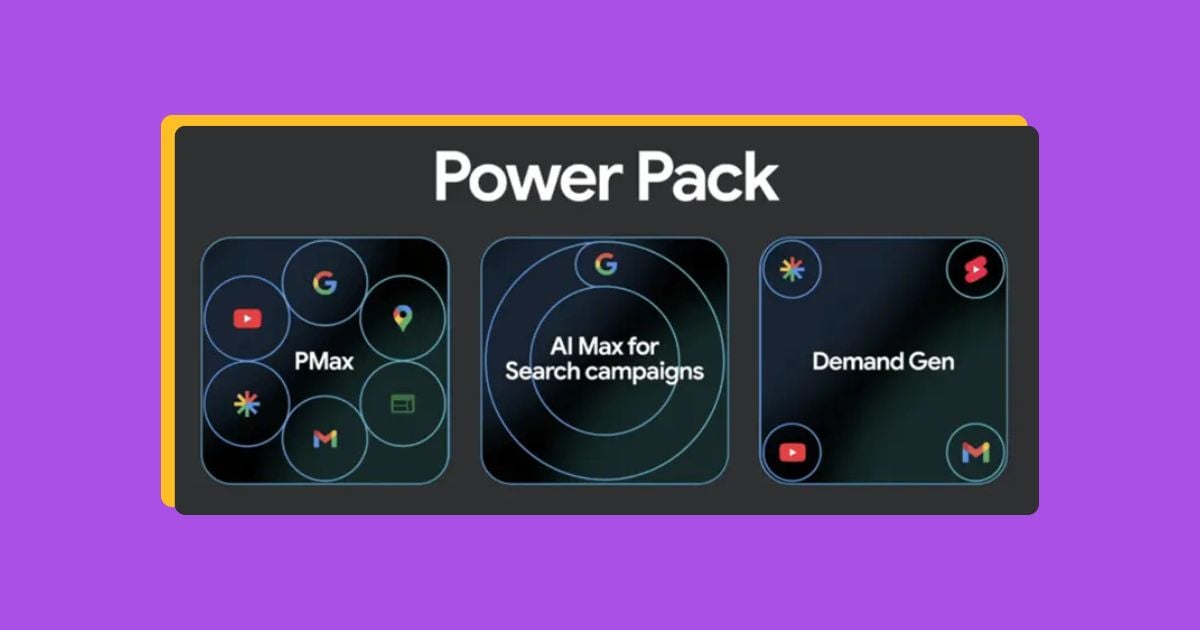Google Ads has been rolling out changes that nudge advertisers toward using more and more automation. If the idea of letting Google handle every aspect of your campaigns once made you nervous, you’re not alone—but with AI getting smarter and Google fine-tuning its tools, most businesses now use at least some automation in their accounts.
One big piece of that puzzle is automated bidding. Automated bidding simplifies your bidding strategy for you based on your budget and goals.
But just because it’s “automated” doesn’t mean it’s simple. There are different automated bidding strategies, each with its own pros and cons. So, should you use automated bidding? And if you do, which strategy makes the most sense for your business?
That’s exactly what we’re going to cover here. We’ll break down manual, automated, and Smart Bidding in Google Ads—plus when to use each—so you can make the most of your ad budget.
Contents
- What is an automated bidding strategy?
- Is Smart Bidding the same as automated bidding?
- Every automated bidding strategy in Google Ads
- How to set your automated bidding strategy
- Which automated bidding strategy should you choose?
What is automated bidding?
When you set up a Google Ads campaign, you have to tell Google how much you’re willing to pay for your ad to be shown. This is called your bid, and there are two different ways to set your bids: manual or automated.
With manual bidding, you tell Google the maximum amount you’re willing to pay per click on your ad (CPC), and you can make adjustments to that bid based on your ad’s performance as determined by the metrics available in your reports.
With automated bidding, Google uses automated rules to adjust your bids for you, based on the ad’s likelihood of getting a click or conversion. Automated bidding may use additional data points that aren’t available in reporting metrics.
There are eight types of automated bidding options in Google Ads:
- Enhanced cost per click (ECPC)
- Maximize Clicks
- Maximize Conversions
- Maximize Conversion Value
- Target Cost Per Action ( tCPA)
- Target Return on Ad Spend (tROAS)
- Viewable CPM (vCPM)
- Cost Per View (CPV)
💡 Your bid strategy isn’t the only thing in your advertising that can be automated! Download our free guide to powerful ways to use AI in Google and Facebook Ads!
Automated bidding vs. Smart Bidding: What’s the difference?
Smart Bidding and automated bidding often get used interchangeably, but they’re not the same thing. Smart Bidding refers only to Google’s automated bidding strategies that use “auction-time bidding,” meaning it will optimize for conversion or conversion value in each and every auction. These include:
- Maximize Conversions
- Maximize Conversion value
- Target CPA
- Target ROAS
So while all Smart Bidding strategies are automated, not all automated bidding strategies are Smart Bidding strategies.

Every automated bidding strategy in Google Ads
Here are all your automated bidding strategy options and their pros and cons.
1. Maximize Conversions
Maximize Conversions is a fully automated bidding strategy, meaning there are no individual keyword bids set by advertisers that Google factors in. It simply chooses a CPC bid based on the goal of the bidding strategy.
The Maximum Conversions bid strategy is designed to get as many conversions as possible while spending your daily budget. Max Conversions also gives you the option to add a target CPA to help guide its bidding.

Although this bid strategy is relatively straightforward, it warrants an abundance of caution. Here are some tips to keep in mind and precautions to take.
Each campaign needs its own daily budget
It’s important that each campaign using Maximize Conversions has its own daily budget assigned, as opposed to being part of a shared budget, as this strategy will always try to spend the full daily allotted budget per campaign. If included in a shared budget, Maximize Conversions will spend the daily budget of the entire shared group, not just its own allotment.
You need conversion tracking in place
Do not run this strategy without having conversion tracking in place. Google’s goal is to maximize the number of conversions being tracked, so if no tracking is enabled, the algorithm is more likely to make bad decisions to find a person willing to convert.
![]()
Keep an eye on CPC
Remember, Google’s algorithm is going to bid whatever it needs to bid to get you the most conversions possible. You may see your spend or average CPC creep up as Google is bidding more aggressively to meet your conversion goals.
However, while Max Conversions has a history of potentially spending more aggressively, the increased conversion rate balances you back out. Your spend or average CPC may be higher, but you’ll have more conversions coming in—resulting in an overall lower CPA and higher ROI. Plus, with the new option to add a target cost per action (CPA), these risks can be kept in control.
In short, if your goal is to get more leads for cheaper, Max Conversions might just work for you. However, if you’re tight on budget, try a target CPA with Max Conversions or go for another strategy instead!
💸 Are you wasting any spend in Google Ads? Find out instantly with the Free Google Ads Grader.
2. Maximize Clicks
This strategy is very similar to Maximize Conversions but instead focuses on clicks. With Maximize Clicks, Google will work to get as many clicks as possible while spending your daily budget.

This strategy can be great if you’re trying to drive more volume to your site for branding and list building, or if you have very strong conversion performance and want to find more volume.
Here are some other tips to keep in mind.
Set a max CPC
Always set a max CPC and keep an eye on your average max CPC as well. Google will work to get as many clicks as possible for your campaign, but as with Maximize Conversions, it will also work hard to spend your entire daily budget each day, even if clicks are far more expensive than normal.
Regularly check on CPC performance
Regularly check in on the CPC performance this bid strategy is generating (and any other goal metrics you have in place) to ensure it’s still meeting your goals. If not, then adjust your settings or potentially look to a new bid strategy.
3. Maximize Conversion Value
Max Conversion Value is the older sibling of the Max Conversions strategy because it’s slightly more advanced.
While the two strategies are fundamentally the same, Max Conversion Value looks to bring in conversions that will give you the highest return.

In other words, it doesn’t necessarily look at how many conversions it’s bringing in, but the value within each conversion. It’s a strategy that looks at quality over quantity.
Similar to how Max Conversions allows you to set a Target CPA, Max Conversion Value gives you the option to set a Target ROAS to help guide its bidding.
There are two points of caution for this bidding strategy.
Track conversions
Just like with Max Conversions, properly setting up conversion tracking is vital to the success of this strategy.
Assign values
Be sure each action is assigned a value, or else the algorithm will be confused.
After all, a conversion worth $1000 to your business deserves a higher bid than one worth only $5. If your tracking is not properly set for value-based bidding, this won’t work.
4. Target CPA (tCPA)
Target CPA stands for target cost per action (or conversion). It used to be a separate bidding strategy but is now only available as an option within the Max Conversions strategy (learn more here).
With tCPA, you set a target cost per action (conversion) and then Google adjusts bids to generate as many conversions as possible at that CPA.
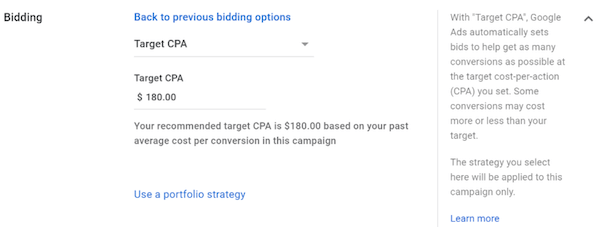
Advertisers are able to set bid minimums and maximums to ensure Google doesn’t adjust bids through the floor or ceiling, but only for portfolio-level use. If you’re targeting for individual campaigns, these bid caps aren’t available.
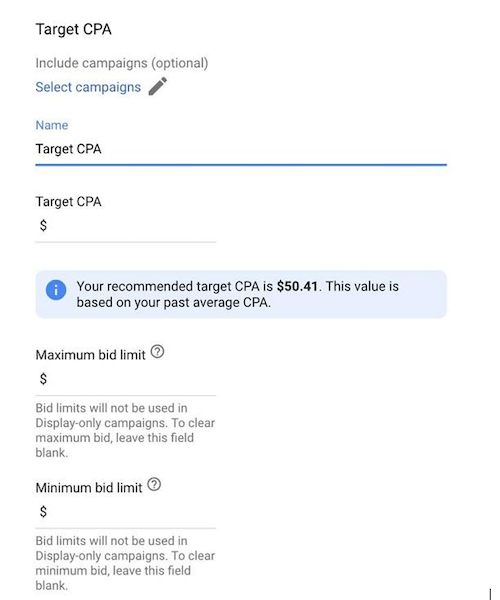
There are three things to note about tCPA bidding.
Set up conversion tracking
Like Max Conversions and Max Conversion Value, Target CPA bidding requires conversion tracking enabled in your account. Without it, this bidding strategy is useless—it will never know if it’s driving conversions or not.
But that’s not all. Just because you have conversion tracking turned on doesn’t mean you’re off to the races just yet.
Provide minimum conversion data
To drive conversion performance, Google needs to have a certain amount of conversion data to be able to make smart decisions. If you don’t have enough conversion volume, then the algorithm can’t make smart decisions, and tCPA isn’t the right bidding option for you.
At the campaign level, Google says the minimum is 15 conversions in the last 30 days, but we’ve found this to be on the low side. Ideally, you should have at least 30 conversions, if not 50, in the past 30 days before testing tCPA bidding.
If your campaigns don’t reach this level individually, they might at a portfolio level. If they still don’t, tCPA likely shouldn’t be on your list of eligible bid strategies.
Set a realistic target
Lastly, when getting started with tCPA, it’s important to set realistic initial goals. If your campaign has had an average CPA of $40 over the past six months, it’s not in your best interest to set a target CPA of $20, as it will limit Google right away in the auctions it can enter in and learn.
If you’re planning to use tCPA bidding, plan on the first two weeks to a month being a learning phase. Set your target CPA slightly higher than what your average CPA has been recently, or use the Google-suggested CPA target to let Google find a groove, then slowly bring it down over time to your target CPA.
5. Target ROAS (tROAS)
Target ROAS is nearly the same as Target CPA, but with return on ad spend (ROAS) instead. And just as tCPA has been reorganized under Max Conversions, tROAS has been reorganized under Max Conversion Value (learn more here).
With this strategy, Google Ads will predict future conversion and conversion value performance based on your historical data to enter auctions, and then adjust bids in real time to maximize conversion value while trying to achieve the target ROAS goal you’ve set at the ad group, campaign, or portfolio level.
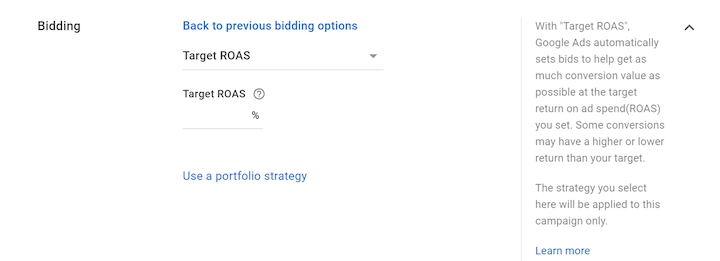
As with tCPA, individual conversions may have higher or lower ROAS than your goal, and Google will work to balance those out over time to achieve your ROAS target.
With tROAS, advertisers can set bid limits (minimums and maximums) at the campaign or portfolio level to help keep the Google algorithm from straying too far, but Google cautions against this as it can limit the machine’s decision-making.
All the same cautions for tCPA apply to tROAS.
Set up accurate conversion tracking
Ensure you have accurate conversion tracking in place including conversion values and that you have enough conversion performance in the recent past to leverage this strategy.
Don’t set your target ROAS too high
Also, be careful not set your target ROAS at a restrictively high level right off the bat. Start off with a goal slightly lower than what your performance has been recently, then slowly raise the target over time to achieve a more profitable ROAS.
6. Target Impression Share
With Target Impression Share, advertisers set a goal impression share percentage in the same way you would set a target CPA for that bidding strategy.

There are three placement options you have to bid for with Target Impression Share:
- Absolute Top of Page
- Top of Page
- Anywhere on the Page
Each of these will tell the Google algorithm different things about your preferences, and it will adjust bids accordingly.
Advertisers are also able to set a max CPC bid with Target Impression Share bidding to help guard against overspend, but Google cautions against setting it too low and throttling performance.
Like any other bidding strategy, this one has the potential to increase your bids beyond the profitability level if you’re not careful. This strategy is focused on awareness and reach (though it can be used for performance), but there are still limits to what makes sense monetarily for your campaigns.
Keep an eye on CPC
Always set a max CPC bid to ensure you don’t pay too much for any individual click. Although Google cautions against it, don’t worry about setting this bid too low to start. Try setting it at a percentage increase over your current bid of 20%-50%. If that works well, then leave that cap. If you’re not seeing the volume you’d like, increase the max CPC.
Have realistic expectations
Very few auctions will actually see 100% coverage anymore. So although you set a target to 100%, don’t be surprised or frustrated if you show up closer to 95% as a top achievable number.
Always keep an eye on CPCs and performance outcomes to ensure this bidding strategy is achieving your goals before continuing with this strategy.
7. Viewable CPM
Viewable CPM (vCPM) refers to cost per thousand viewable impressions. According to Google, an ad is counted as viewable when 50% of your ad shows on screen for one second or longer for Display ads, and two seconds or longer for video ads.
This is a Display-only bid strategy designed to let advertisers bid for impressions when your ad is shown in a viewable space.

vCPM bidding is great if you’re working on expanding your brand coverage and simply want to get your message in front of a large group of people.
There are a couple of things to watch out for with vCPM bidding: frequency and placements.
Be mindful of frequency
With this strategy, Google will look to maximize the number of viewable impressions your ad receives. When using this strategy with a finite audience, your chances of hitting a high frequency count for each user go up.
We’ve all had the ads that seem to stalk us as we peruse the internet, so be sure that although you’re trying to maximize ad views, you’re not doing it at the expense of a small audience who now feel overwhelmed by your brand.
Keep an eye on placements
Additionally, not all viewable impressions are created equal. Just like any other display campaign, it’s important to keep an eye on your placements report to ensure you’re not showing up on unwanted sites.
8. Cost Per View (CPV)
Bidding on individual views is only available for video ads. With Cost Per View, you set a campaign-level bid limit that implies the maximum you’re willing to pay for each view or interaction with your video (whichever comes first).
In this case, you’d only be charged for a view if someone watched your video for more than 30 seconds (or the entire video if it’s shorter than 30 seconds). Otherwise, if the viewer instead clicks on a link the video shares or takes part in other calls to action (app download, etc.), you will be charged for that interaction.
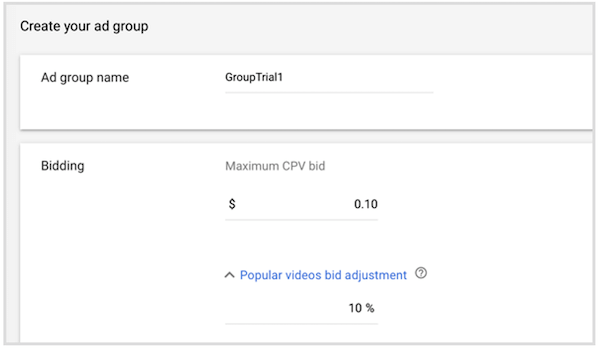
The nice thing about CPV bidding is it also allows you to “bid up” when you show alongside popular YouTube videos that may be more likely to bring you in a return.
Set up the right targeting
Beware if you have loose targeting on your video campaigns! If you’re bringing in TONS of views at a cheaper cost, it most likely won’t make sense for you to use CPV.
Only spend when it counts
Since you’re bidding on individual views, you only want to spend when it really counts. So if you have looser targeting this will be tougher to gauge. Additionally, video views and average costs per view tend to be relatively cheap.
This makes CPV a great strategy for a hyper-focused video campaign in a highly competitive space, but not the best for those just starting out in video ads.
A note on Manual Cost Per Click (CPC)
Although Manual CPC is not an automated bidding strategy, it’s still worth mentioning in our bid strategy roundup as it’s the easiest bid strategy to grasp on the Google Ads platform. Advertisers set their bids manually at the keyword level, and the bids stay where they are until the advertiser changes them.

Despite the friendly warning from Google, this is the best place to start for folks starting out in PPC or using their spare time to manage their account but has its drawbacks.
Despite the friendly warning from Google, this is a recommended place to start for folks starting out in PPC or using their spare time to manage their account.
Manual bidding has two drawbacks:
It takes a lot of time
When it comes down to it, manual bidding requires a time investment to look at performance, judge if the keyword bid needs to change, decide what that change needs to be, and then actually make that change.
You could be underinformed
When we review our performance metrics, we’re at the whim of the metrics Google allows us to see for our campaigns. With automated bidding strategies, Google is able to take data points into account that we don’t even know exist.
These two downsides don’t mean all automation is good and that manual bidding isn’t the right solution for you. But they are something to consider when determining bid strategies.
How to set your automated bidding strategy
Once you determine which automated bidding strategy is right for you, how do you select it?
It’s important to note that when you’re setting up your campaign, Google will automatically choose an automated bidding strategy for you based on your goals.
You do not have to use this strategy!
You can choose any other automated bidding strategy, or instead choose to bid manually.
Simply select the blue text at the bottom where it says “Select a bid strategy directly (not recommended)”
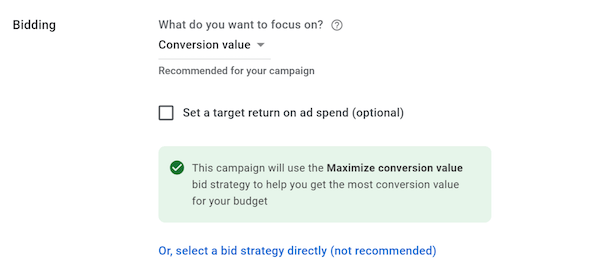
Alright, so now that you know the basics of Google Ads bidding, let’s go through every option you have for bidding.
Which automated bidding strategy should you choose?
Now that we’ve covered all the automated bidding strategies, it’s time to choose the one that’s right for your whole account, right?
Wrong!
The best thing about automated bidding and bid management: we can pick and choose what we use where.
Google Ads allows for automated bidding strategies to be set at either the ad group, campaign, or portfolio level, depending on the strategy you choose. This means you can direct different aspects of your account to rely on different bid strategies depending on their goals.
When choosing a bid strategy, evaluate at the campaign level to determine if the strategy will help accomplish your goal and if you have enough data to make it work (e.g., enough conversion volume to make Target CPA effective). If not, you might benefit from another bid strategy, a portfolio-level strategy, or even an adjustment in account structure to better leverage it later on.
Set it and don’t forget it
Automated bid strategies in Google Ads are a fantastic way to save time while leveraging algorithms to optimize your account, but only when evaluated and chosen wisely.
And even though automated bidding strategies require less maintenance than manual bidding, there’s no such thing as “set it and forget it.” Once these strategies are leveraged in your account, set reminders to check in on them to ensure they’re still accomplishing the goals they set out to hit. Happy automating!
For more help navigating your automated bidding strategies, see how our solutions can optimize your approach to Google Ads for maximized success!






